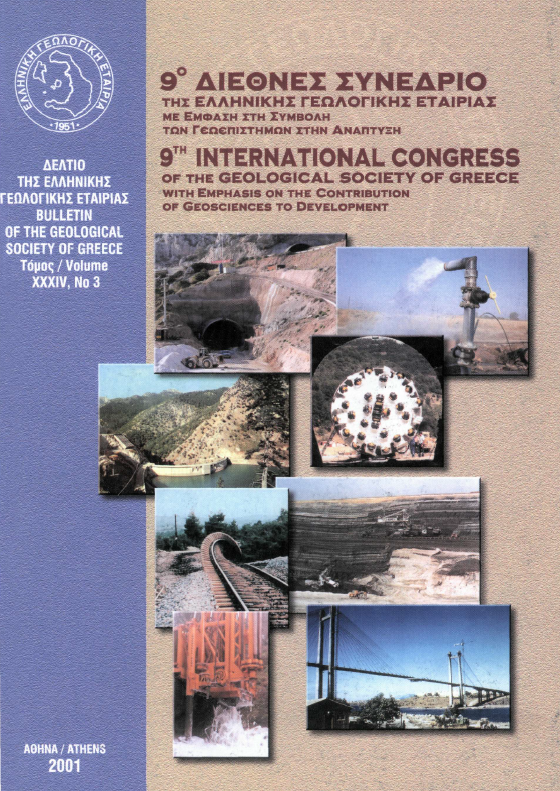Rhenium - rich molybdenites in Thracian porphyry Mo±Cu occurrences, NE - Greece

Abstract
The present study correlates both the mineralogy of the hydrothermal alteration and the mineral chemistry of molybdenites from three porphyry Mo ± Cu occurrences in Thrace: Melitena, Pagoni Rachi/Kirki and Ktismata/ Maronia. The mineralisations are genetically related to calcalkaline, subvolcanic bodies of Tertiary age. According to their mineralogical and chemical composition the host rocks are characterized as dacite (Melitena), dacitic andésite (Pagoni Rachi) and porphyry microgranite (Ktismata/Maronia). The molybdenites occur in disseminated form, as fracture fillings, as well within quartz stockworks crosscuting the central alteration zones of the intrusives. They are accompanied by the following mineral assemblages: quartz, sericite, pyrophyllite, diaspore, Ca-Ba-rich alunite, pyrite (Melitena); quartz, albite/K-feldspar, biotite, actinolite, magnetite (Pagoni Rachi); and sericite, kaolinite, pyrophyllite, chlorite (Ktismata). Preliminary microthermometric results showed homogenisation temperatures from 352° to 390 °C for Pagoni Rachi area and from 295° to 363 °C for Melitena area. The salinities range between 4.5 and 6.1 wt% eq. NaCl and between 2.7 and 3.4 wt% eq. NaCl, respectively. Detailed study on over 400 fluid inclusions from the porphyry Cu-Mo deposit in Maronia area revealed formation temperatures from 300° to 420 °C, whereas salinities are distincted in two different groups from 6 to 16 wt% eq. NaCl and from 28 to 55 wt% eq. NaCl. The chemical composition of the molybdenites from the three porphyry Mo±Cu deposits in Thrace was studied with 155 microprobe analyses. The results revealed unusual high and variable Re concentrations in the studied molybdenites. Re content in molybdenite from Melitena area vary from 0.21 to 1.74 wt%, 0.79 wt% on average. The highest values were measured in samples from Pagoni Rachi (0.45-4.21 wt%, 1.98 wt% on average). Finally, microprobe analyses from molybdenite in Ktismata/Maronia showed Re content between 0.12 and 2.88 wt% (0.76 wt% on average). Rhenium is a very rare element with many definite uses, and is mainly associated with molybdenite in porphyry type deposits. According to the data published so far the Re content in molybdenite reaches up to 0.42 wt%. It is obvious therefore that such high Re concentrations (0.12 to 4.22 wt%) from the studied molybdenites in Thrace, are very ineresting for a possible future exploitation.
Article Details
- How to Cite
-
ΜΕΛΦΟΣ Β., ΒΟΥΔΟΥΡΗΣ Π., ΑΡΙΚΑΣ Κ., & ΒΑΒΕΛΙΔΗΣ Μ. (2001). Rhenium - rich molybdenites in Thracian porphyry Mo±Cu occurrences, NE - Greece. Bulletin of the Geological Society of Greece, 34(3), 1015–1022. https://doi.org/10.12681/bgsg.17139
- Section
- Geochemistry and Ore Deposit Geology

This work is licensed under a Creative Commons Attribution-NonCommercial 4.0 International License.
Authors who publish with this journal agree to the following terms:
Authors retain copyright and grant the journal right of first publication with the work simultaneously licensed under a Creative Commons Attribution Non-Commercial License that allows others to share the work with an acknowledgement of the work's authorship and initial publication in this journal.
Authors are able to enter into separate, additional contractual arrangements for the non-exclusive distribution of the journal's published version of the work (e.g. post it to an institutional repository or publish it in a book), with an acknowledgement of its initial publication in this journal. Authors are permitted and encouraged to post their work online (preferably in institutional repositories or on their website) prior to and during the submission process, as it can lead to productive exchanges, as well as earlier and greater citation of published work.




